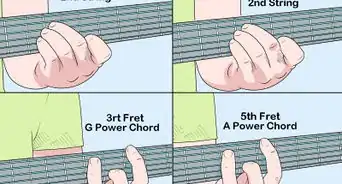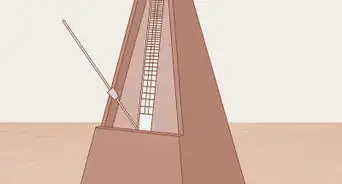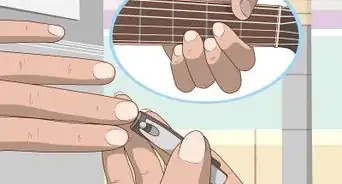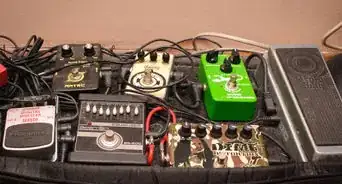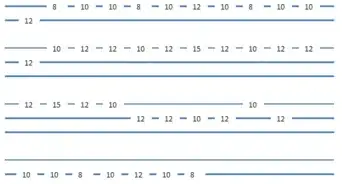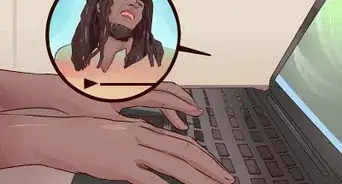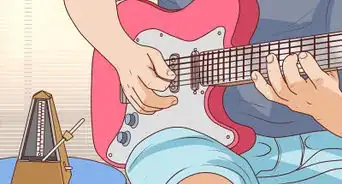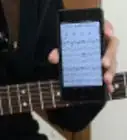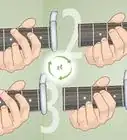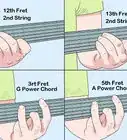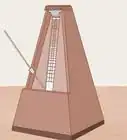X
This article was co-authored by Nate Savage. Nate Savage is a professional guitarist with over 16 years of experience teaching guitar to students around the world. His YouTube channel, Guitareo, has over 450,000 subscribers.
This article has been viewed 68,432 times.
Learning guitar can be a long, arduous process. However, this doesn't mean that you can't wow friends by playing simple songs as soon as you know some basic chords. In fact, this is a great idea for fostering your development as a guitarist — getting confident playing basic songs will improve your sense of rhythm and help you develop confidence.[1]
Steps
Method 1
Method 1 of 2:
Knowing the Essential Chords
-
1Learn a G major. Place your ring finger on the top string (the sixth string), on the third fret. Your middle finger goes a string below on the second fret. Then use your pinky to play the third fret on the lowest, thinnest string (the first string). You can also play this chord with your index, middle, and ring fingers, though it is harder to transition to other chords like this. Strum all strings.
- --3--
- --0--
- --0--
- --0--
- --2--
- --3--
-
2Learn a C major. Your fingers form a diagonal line up towards your face. Your ring finger is on the fifth string (the A string), third fret. Your middle is on the third string, second fret, and the index goes down on the second string, first fret.
- --0--
- --1--
- --0--
- --2--
- --3--
- --0--
Advertisement -
3Learn a D major. Place your index finger on the third string, second fret. Place your middle finger on the first string, second fret, then finally lay your ring finger on the second string, third fret. You'll have a little triangle with your fingers on the bottom three strings. You only strum the bottom four strings.
- --2--
- --3--
- --2--
- --0--
- --x--
- --x--
-
4Learn an E major and minor. Place your second finger (middle) on the second fret of the A string. Place your ring finger down on the second fret of the D string. Finally, place your index finger on the first fret of the G string, the third string from the bottom.
- --0--
- --0--
- --0--
- --2--
- --2--
- --0--
- Make an E-major chord by simply adding your index finger on the third string, first fret.[2]
Advertisement
Method 2
Method 2 of 2:
Learning Simple Four-Chord Songs
-
1Purchase a capo to make it easier to sing or adjust pitch. A capo clamps down on all six strings, allowing you to play these chords anywhere on the neck. Basically, wherever the capo goes becomes the new "0" in your chords. This allows you to keep the same shape and play songs in any key.
- The following songs have a capo in them, but you can still play them without one. Note, however, that the songs will sound off-key from recorded versions.
-
2Play Boston's "Piece of Mind" with a capo on the ninth fret. This great little riff sounds good electric or acoustic. It has a fast rhythm to it -- one strum on the first and third chords, two on the second and forth. If you can throw in some muted notes, even better.
- Capo: 9th
- Chord Shape Progression: Em - C - G - D
-
3Play Beyonce's "If I Were a Boy." A slower tempo song, this sounds great on acoustic. Simply strum down four times on each chord. It is just a slower version of the Boston song.
- Capo: 11th
- Chord Shape Progression: Em - C - G - D
-
4Play Green Day's "When I Come Around." Simple and easy, play four strums on the first two chords. Then strum the third chord twice, once coming up with the pick. Then play the final chord four times.
- Capo: 11th
- Chord Shape Progression: G - D - Em - C
-
5Play Bon Jovi's "It's My Life." Play eight driving, quick strums on each chord, or four sets of up/down strumming. Keep this consistent beat (these are eighth notes) going.
- Capo: 8th
- Chord Shape Progression: Em - C - G - D - Em - C - D
-
6Play Bob Marley's "No Woman No Cry." This requires a simple reggae "up-stroke" pattern. Only play the chord by picking upwards, towards your face. As your hand comes back down, lift your fingers slightly off the chord so you get a muted "chick" as you strum down the guitar, towards your feet.
- Capo: 5th
- Chord Shape Progression: G - D - Em - C - G - C - G - D
-
7Play The Beatles "Let it Be." Just like Bon Jovi's song, you just need gentle, calm strums. For each measure ("1 and, 2 and, 3 and, 4 and, 1 and..."), you want to strum on the "1," pause, the strum twice for the "2 and." Play the "3," pause, then strum twice for the "4 and."
- Capo: 5th
- Chord Shape Progression: Em - D - C - G - D - C - G
-
8Play Eagle Eye Cherry's "Save the Night.: Simple and easy, strum it like normal for the entire bar, but hit the last chord, right before you switch, harder and louder.
- Capo: 5th
- Chord Shape Progression: Em - C - G - D
-
9Play Aerosmith's "Cryin'." The strumming is simple and basic -- three up/down strums for each chord.
- Capo: 2nd
- Chord Shape Progression: G - D - Em - C - G - D - C.
-
10Play John Denver's "Country Roads." Another simple, folksy strum pattern. At the beginning of every measure, just strum the top string of the chord to get a nice, bouncy feel to the song.
- Capo: 2nd
- Chord Shape Progression: G - D - Em - C - G - D - C - G
-
11Play Joan Osborne's "One of Us." This final song has a few nifty tricks in it to push your guitar skills, but you can skip them if you're still practicing. To get the intro riff, you use all the same notes in your normal chords. When transitioning chords, simply keep the last three strings in place for 1 measure. So, going from the D to the Em, leave the bottom three strings as a D for the first strum of Em, then lift them.
- Capo: 2th
- Chord Shape Progression: D - Em - C - G - D - Em - C - G - D[3]
Advertisement
Community Q&A
-
QuestionWhy would I use a capo?
 Community AnswerA capo makes certain chords easier to play, because you can suddenly play barre chords as open chords, because the capo holds the notes you would have to bar down for you. It also changes the texture and timbre of particular chords. A G chord played as a D form above the seventh fret sounds bright, whereas a standard G form sounds full and mellow.
Community AnswerA capo makes certain chords easier to play, because you can suddenly play barre chords as open chords, because the capo holds the notes you would have to bar down for you. It also changes the texture and timbre of particular chords. A G chord played as a D form above the seventh fret sounds bright, whereas a standard G form sounds full and mellow. -
QuestionHow much is a capo?
 Kaylin LameyCommunity AnswerCapos can be anywhere from $5-$50. You can buy capos online or in music stores.
Kaylin LameyCommunity AnswerCapos can be anywhere from $5-$50. You can buy capos online or in music stores. -
QuestionHow do I keep my fingers from getting sore?
 Community AnswerAfter you play guitar for a while your fingers will get used to it. Your fingers might only hurt for a little bit as a beginner; play less at the beginning, then slowly build up.
Community AnswerAfter you play guitar for a while your fingers will get used to it. Your fingers might only hurt for a little bit as a beginner; play less at the beginning, then slowly build up.
Advertisement
References
- ↑ http://healthland.time.com/2013/05/20/10000-hours-may-not-make-a-master-after-all/
- ↑ http://www.guitarlessons.com/guitar-lessons/guitar-lessons-for-beginners/play-10-songs-with-4-chords/
- ↑ http://www.guitarlessons.com/guitar-lessons/guitar-lessons-for-beginners/play-10-songs-with-4-chords/
- Videos from GuitarLessons.com
About This Article
Advertisement

